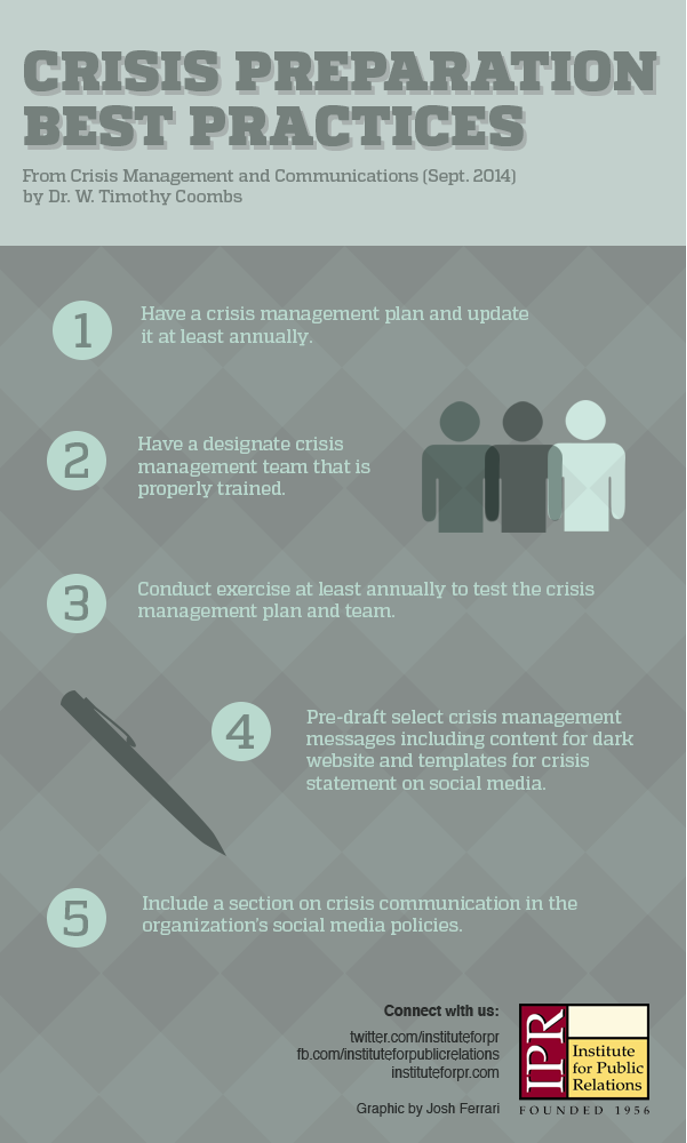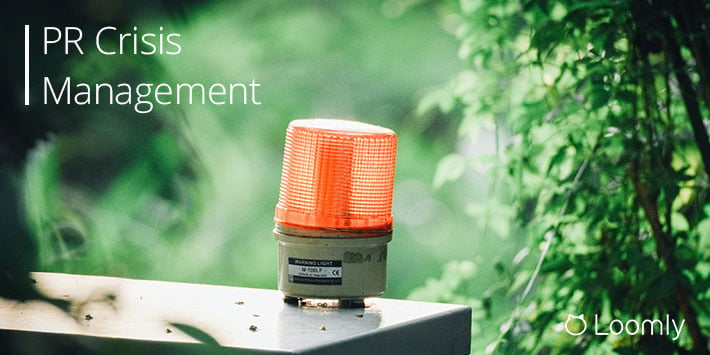Most brands will face a PR crisis at one time or another. Whether it’s a negative review or an executive scandal, bad news travels fast, especially on social media.
One thing’s for sure: burying your head in the sand and hoping the crisis will disappear won’t work.
Your best chance of surviving a PR crisis is to plan and prepare ahead, or even better, prevent a disaster before it happens.
And that’s what this guide is all about:
- What is a PR crisis?
- How does a PR crisis happen?
- Examples of successfully managed PR crises
- How to mitigate a PR crisis
- How to prevent a PR crisis
Let’s begin.
What is a PR Crisis?
A PR crisis can be defined as an organization or an individual receiving negative, humiliating, or damaging publicity that affects their operations or reputation.
A PR crisis can occur at any moment and may have substantial consequences when it’s not handled properly.
How Does a PR Crisis Happen?
A PR crisis can happen following a compliance breach, data breach, executive scandal, negative review, failed event, or poorly planned marketing campaign.
Some of the types of events include:
- Lawsuits and legal actions
- Community- or Government-based challenges
- Product availability issues
- Product flaws
- Recalls and accidents
- Business acquisitions
- Key customer defections
- Labor relations challenges
- Loss of key executives
The biggest scandals usually affect the biggest brands, but small brands are not immune. For example, the most common PR crises to hit small businesses include:
- Not answering complaints
- Replying negatively to customers
- Posting controversial content on social media
- Publishing insensitive content at the wrong time
- Ignoring issues and hoping they’ll disappear
So what’s the best way to deal with a PR crisis?
Examples of Successfully Managed PR Crises
It can take years to build a brand’s reputation, and moments to tarnish it.
Here’s how these brands successfully managed PR crises that threatened their brand reputation, revenue, and customer trust.
FedEx — Owning up
A few years back, FedEx faced an embarrassing situation when a YouTube video emerged of a FedEx driver throwing a boxed computer monitor over a fence instead of ringing a customer’s buzzer.
What started as a customer service issue quickly turned into a PR crisis as the video went viral with millions of views.
Instead of reminding customers of their excellent delivery service, FedEx decided to apologize to everyone about the unfortunate incident.
FedEx senior vice president Matthew Thornton said:
“I am upset and embarrassed for our customer’s poor experience. This goes directly against all FedEx values. It’s just not who we are.”
FedEx added that the employee is no longer working with customers following the incident.
Kudos to FedEx for owning up, apologizing, and responding to the damaging PR crisis to reinstall trust in their service and brand.

Manage all your social media accounts in one place.
Craft, schedule, & auto-post content to all your social channels, then track analytics and manage interactions from a single, easy-to-use dashboard.
Southwest Airlines — Immediate Response
The way in which a brand responds to a crisis can make or break its chances of saving its reputation. An immediate response can dampen any potential fires while dithering and delaying only adds fuel to the fire.
When flights get delayed, passengers want to know what’s going to happen:
- Will the flight make up time?
- Will the airline hold connecting flights?
It’s a situation that can turn into a major PR crisis if it’s not managed quickly and effectively.
When a Southwest Airlines flight was delayed, the quick reactions of an employee turned the near-crisis into a PR win. The quick-thinking gate attendant turned the situation into a fun moment by playing games with the waiting passengers.
As people grew tense waiting 2.5 hours for their delayed flight, the gate attendant awarded prizes (Southwest merchandise and $25 vouchers toward future flights) for the worst driver’s license picture and a paper airplane contest.
Toyota — Recovery of a Brand’s Reputation
Between 2009 and 2010, Japanese carmaker Toyota had to recall millions of vehicles worldwide due to accelerator pedal, brake, seatbelt, and exhaust problems. It was a torrid time that put a big dent in their sales and brand reputation.

Credit: MotorTrend
Looking at the brand today, you wouldn’t know they’d experienced such a crisis.
Toyota managed to recover its brand image through proactive storytelling of its successful track record as well as making executives available to speak to the media. The recall fiasco was a blip, and Toyota restored its brand perception by highlighting past successes and emphasizing their future quality standards.
How to Mitigate a PR Crisis
Nobody wants to experience a PR crisis, but in today’s always-on digital world, you can’t bury your head in the sand and hope it never happens. You have to be well-prepared to handle any potential disaster with a PR crisis team and an action plan in place to soften the blow and protect your brand.
Let’s take a look at how you can mitigate a PR crisis for your brand.
Stage 1: Before a PR Crisis
The first stage is all about planning for a potential crisis. When disaster strikes, you need an action plan that’s ready to implement.
Step 1: Use social listening and media monitoring to create alerts
By using a social listening tool to monitor media channels, you can identify early signs of a potential crisis. For example, you might pick up on a negative tweet or spot negative brand sentiment.
Step 2: Build a cross-departmental crisis response team
When a crisis strikes, you’ll need key members from every department available to help, such as PR, customer service, sales, marketing, legal, HR, and executive leadership, plus any external experts.
Also, aim to make your team diverse with different races, genders, ages, and politics, so you get different perspectives to match your audience.
Make sure you have a well-defined escalation process so you can filter and escalate issues depending on the crisis severity. For example, a minor issue won’t need the CEO’s attention.
Also, nominate a spokesperson so that all communication goes through one person.
Step 3: Create your PR crisis management plan
Take the time to create your PR crisis management plan, so everyone knows what to do. The last thing you need is a panic reaction that makes things worse.
Your PR crisis management plan should include:
- A checklist of what needs to be done.
- Guidelines for identifying the type and severity of a crisis.
- Roles and responsibilities for every department.
- An internal communication plan to keep employees updated.
- Contact details of the crisis response team members and their deputies.
- Any pre-approved draft messages, such as templates for press releases, social media posts, interview Q&As, etc.
- Approval processes for posting messages on social media.
- A link to your social media policy.
Step 4: Create several response templates
It’s not possiblle to write exact responses before you know what the crisis entails, but you can create some holding templates.
For example, an airline might have something like:
“We’ve implemented our crisis response plan, which prioritizes the safety of our passengers and team. Additional details will be posted on our website and social channels as soon as possible.”
Here’s a fill-in-the-blank statement that could be used in several situations:
“A ___________________ at ___________________ involving __________________ occurred today at _________________. The incident is under investigation and more information is forthcoming.”
Step 5: Do a dummy run
Last but not least, it’s good practice to do a dummy run so you can evaluate your plan and ensure all parties know what’s expected.

Stage 2: During a PR Crisis
With your planning and preparation in place, here are the six steps to follow during a PR crisis.
Step 1: Press pause and take a deep breath
A PR crisis requires a calm head and a clear plan. Now is the time to press pause rather than reacting too quickly. Remember, you’ve got a crisis management team and an action plan, so now is the time to put them into practice.
It’s also a good time to pause all your scheduled social media posts. These were planned and approved before your crisis, and if they’re published, they could inadvertently make things worse.
Step 2: Investigate and gather information
Before you can resolve a situation, you need to know the facts. Start off by investigating what’s happened so far and collating information for an initial team briefing. Try and get both an internal and external perspective of the situation. Understand what impact it’s having on your business and how it’s affecting your customers.
Step 3: Identify the affected parties
Every disaster has victims, and you need to identify which parties are involved, such as employees, stakeholders, business partners, customers, and the media.
- Have you offended someone?
- Whose data has been breached?
- Which passengers are affected by the flight cancellations?
Also, check your social listening tools to see how many people are voicing opinions on the crisis. Check if the media have got wind of the incident.
Based on your intel, you can also identify influencers and brand ambassadors who could help you with a positive response.
Step 4: Decide on your position
Now that you have a clear picture of what’s happening and who’s affected, it’s time to decide how you’re going to manage the issue and how you’ll respond.
Inform people what you’re going to do to rectify the situation and how you’ll avoid it happening again.
A great example of this is how Starbucks handled their scandal:
- Apologize right away.
- Take responsibility for the incident.
- Make it clear that it won’t happen again.
Step 5: Get your message out
Once you’ve decided on your stance, it’s time to get your message out. Remember from your planning – this should be via a nominated spokesperson.
You’ll also need to make sure you include all relevant channels. For example, you can post on your blog, on social media, in a press release, or a combination. But each channel is different, so you’ll have to adapt your message accordingly. For example:
- Social media will involve a conversation, so your team must be ready to respond to comments in a controlled manner within agreed parameters (Loomly Interactions can help here).
- Blog posts give you greater control, and you can talk with one company voice.
- Press releases are broadcast globally and picked-up by news agencies.
- Television and radio will require training, experience, and an agreed script, but you can reach a wider audience.
Step 6: Monitor the situation
You need to keep monitoring the situation after you’ve delivered your message.
- Is the crisis still a crisis?
- Do you need to take further action?
- What are the follow-up questions or concerns?
Be ready to change your plans accordingly.
Stage 3: After a PR Crisis
With the PR crisis under control, it’s time to reflect and learn, so you’re better prepared for next time.
Step 1: Keep monitoring
Although the crisis might appear to be over, it’s wise to keep monitoring social and media channels for positive or negative brand sentiment, specifically related to the incident.
Step 2: Review and learn from the crisis
Once the crisis is over, it’s a good idea to conduct a post-crisis review and check how well your crisis response team handled the situation.
Discuss what went well and what could have been done differently, and decide if any changes are necessary to the crisis management plan.
Step 3: Tell a positive story
Now is the time for your PR team to start telling a positive story about your brand and repair any damage to your reputation.
How to Prevent a PR Crisis
Rather than having to manage a PR crisis, follow these 9 tips for preventing a PR disaster in the first place.
1. Establish communication policies
Some of the worst crises occur when an employee posts something inappropriate on social media, or sends a badly-written email, or says something offensive on the phone.
The best way to prevent this type of crisis is to establish clear communication guidelines so that everyone knows what’s expected of them when communicating with the public.
Here are some topics to include:
- Copyright guidelines about how to use and credit third-party content.
- Privacy guidelines on when a conversation needs to move from a public to a private channel.
- Confidentiality guidelines that describe what business information employees are not allowed to disclose and what approved content they are encouraged to share.
- Brand voice guidelines on the tone and style to use in different settings.
2. Implement a content approval workflow
As a best practice, no content, including social media posts, blog posts, press releases, interviews, podcasts, videos, etc. should be published without approval.
An approval workflow is a proven system that allows your team to move a piece of work closer to completion. It can be characterized as having multiple people from different teams and departments working together towards a common goal across numerous different stages.
Each person has a defined role. For example, a cross-functional team may include:
- Sales: to check the correctness of any sales messages.
- Product: to check the accuracy of product information.
- HR: to ensure the updates are in line with company policy.
- Finance: to ensure there are no budget issues.
- Legal: to ensure there are no liability issues.
- Third-Parties: any clients, agencies, or contractors you may be working with.
Using an approval workflow helps to reduce mistakes, save money, and improve the overall quality of a piece of work or project.
3. Secure your social media accounts
If you fail to secure your social media accounts, you run the risk of being hacked and the perpetrators posting inappropriate content, which could damage your brand.
Consider using social media policy guidelines (in conjunction with IT) on how to:
- Create a secure password and how often to change it.
- Keep software and devices updated.
- Identify and avoid spam, phishing attacks, and other security threats.
- Report social media security concerns.
- Avoid social media platforms’ default privacy and security settings.
- Avoid social media activities that ask for personal information.
- Share on-brand and approved content.
- Adhere to copyright and confidentiality rules.
- Engage appropriately on behalf of the brand.
4. Monitor your social media channels
Actively monitoring your social media channels with a social listening tool such as Google Alerts or Mention helps you identify potential problems before they escalate into a major crisis.
Social listening allows you to effectively:
- Gather feedback – Are people happy with your service?
- Interpret conversations – Is there a policy that has either upset or delighted customers?
- Understand brand sentiment – How do people feel about your brand versus your competitor?
Listening helps you decide what changes to make to keep customers happy.
5. Provide fantastic customer service
If customers love what you sell and how you treat them, they’re unlikely to complain and more likely to recommend you to others.
6. Respond to customer complaints quickly and effectively
If you receive a customer complaint, you can nip it in the bud by responding swiftly and effectively.
Avoid any knee-jerk reactions. Gather your thoughts and respond courteously and professionally.
Ignore it at your peril. It only takes one disgruntled customer to start posting a negative review before more join in.
7. Do the right thing
Doing the right thing will always lead to better results and fewer problems. These decisions may include giving the correct response to a customer service inquiry, adding the right features to a product launch, or declining a prospective client because you’re not the right fit.
8. Remain transparent
If you’re transparent in your brand messaging, your customers will trust you more: according to the latest figures, 70% of consumers agree that brand trust is more important today than in the past.
People want companies to be honest and transparent: in a 2016 study, 94% of consumers stated that transparency in a business was essential in gaining their loyalty.
One way you can show your transparency is by taking customers behind-the-scenes of your business so they can experience your culture. For example, you could feature “star employees” or host AMAs on social media.
9. Always expect the unexpected
Be prepared. You never know what’s around the corner, but by learning from other companies and your own mistakes, you can at least be more aware of the dangers.
PR Crisis Management in a Nutshell
Nobody wants to experience a PR crisis, but in today’s always-on digital world, you can’t bury your head in the sand and hope for the best. You have to be well-prepared to handle any potential disaster with a PR crisis team and action plan to limit the damage and protect your brand.
Learn from experience and review other parts of your business to make sure you’re preventing possible future crises by responding quickly to customer inquiries, tackling issues, improving quality control, and offering better products and customer service.



